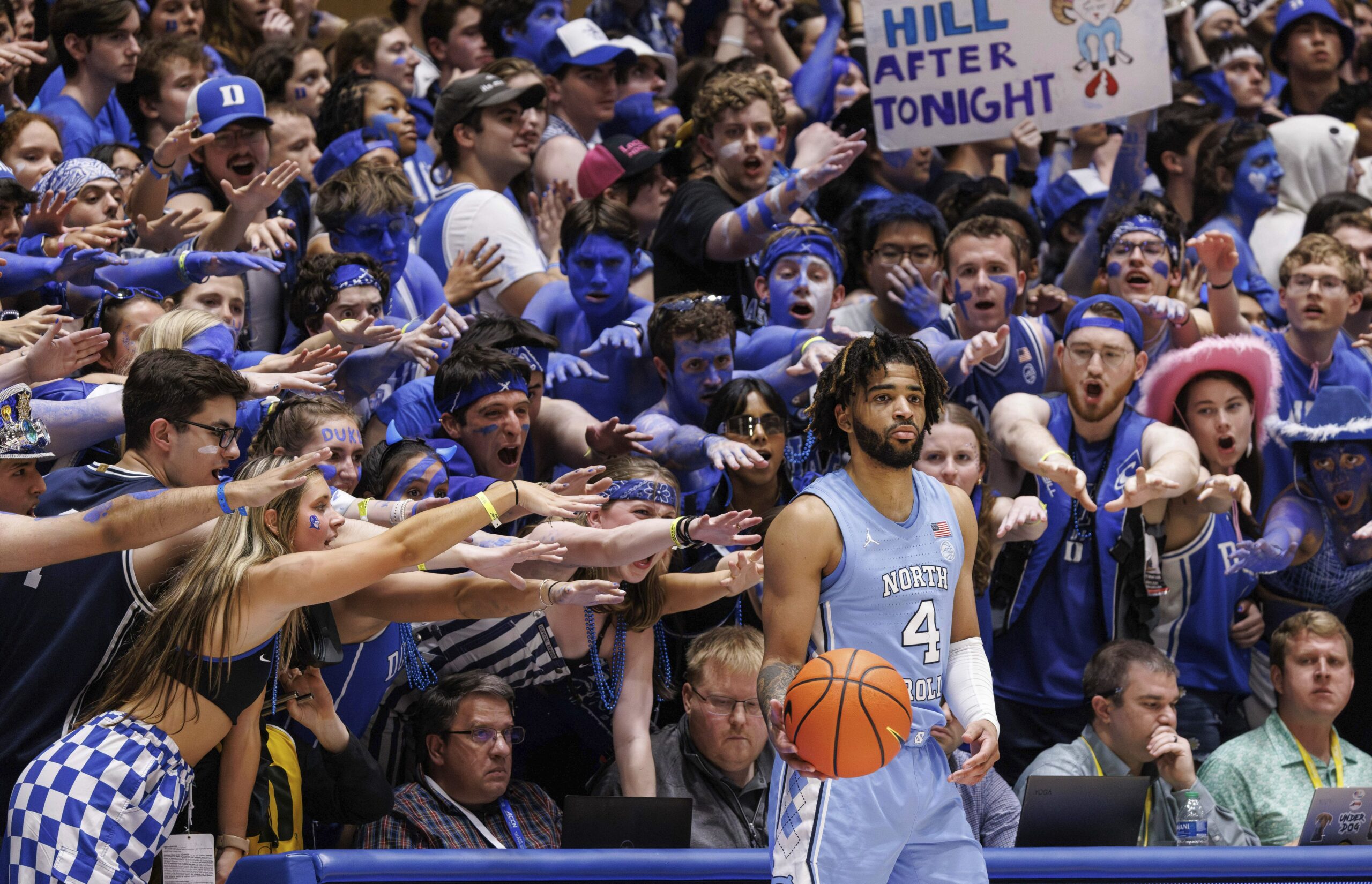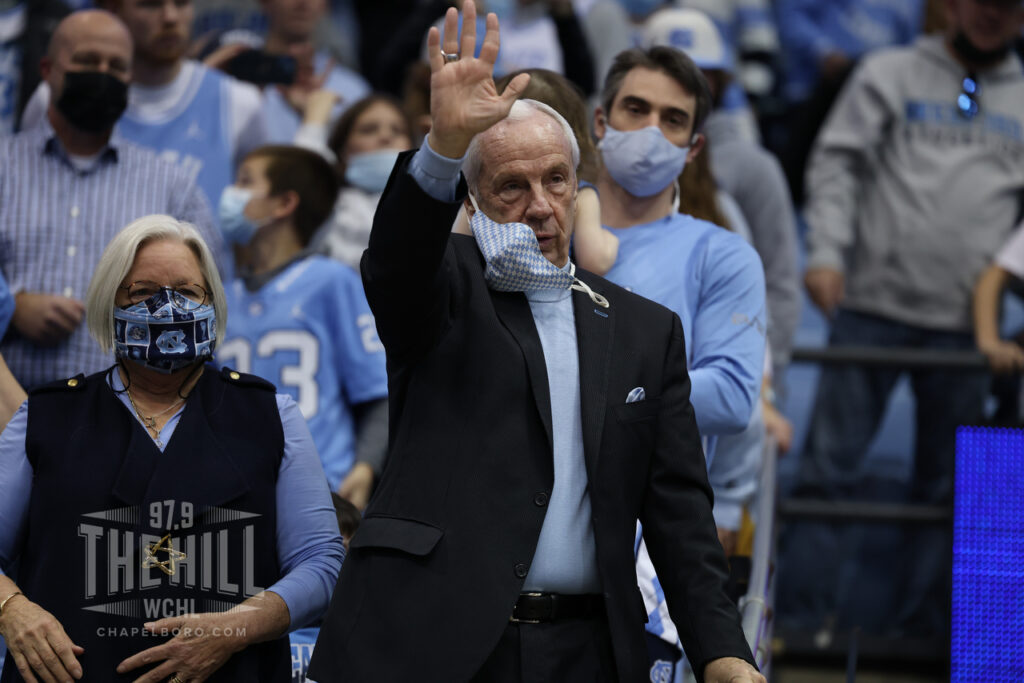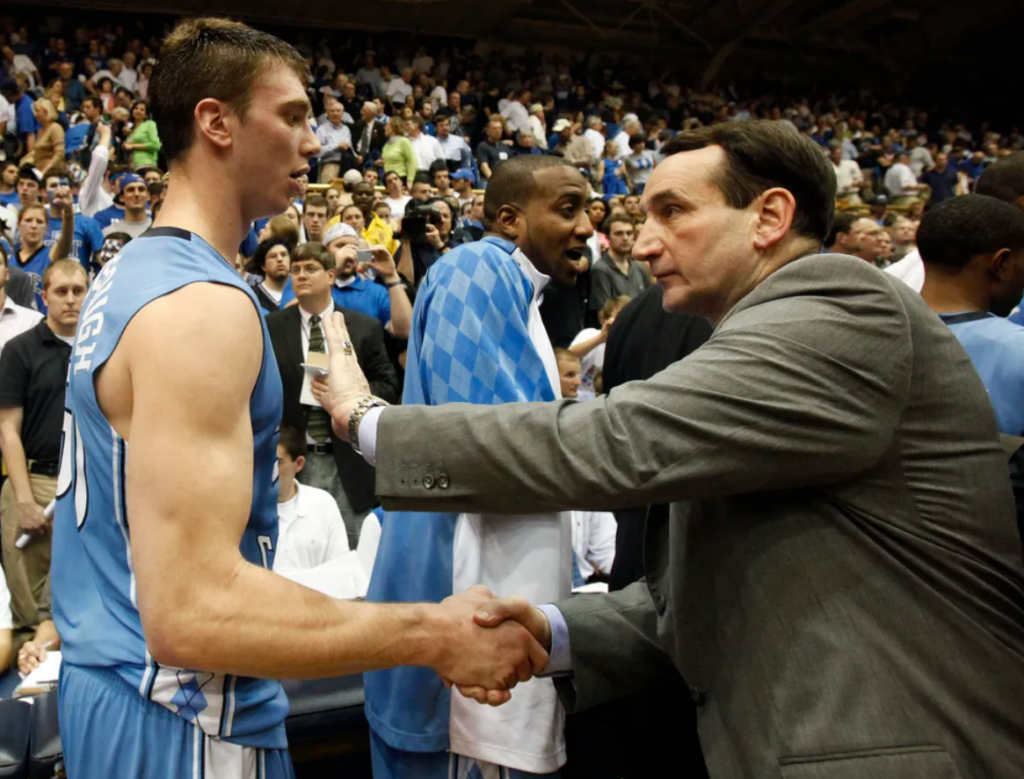2024 ACC Tournament Fun Facts: Duke-Carolina, Bubble Dreams, Mvps, Refs, Cheerleaders, More
By David Glenn
As the Atlantic Coast Conference men’s basketball tournament unfolds with plenty of juicy storylines this week (Tuesday-Saturday) in Washington, D.C., here are 10 historical “fun facts” worth considering about the crown jewel of ACC basketball:
- 23-Year Duke/UNC Run (1997-2019)
Since North Carolina and Duke are this year’s #1 and #2 ACC Tournament seeds, respectively, let’s begin with perhaps the most stunning tidbit in the 71-year history of the event.
From 1997 through 2019, a 23-year stretch that ended not long ago, if you witnessed an ACC championship game, there was a 100 PERCENT CHANCE that you were watching UNC, Duke or both teams.
Amazingly, the majority of that streak occurred while the conference had 12 or 15 members, rather than when it was a seven- or eight-team league, when it theoretically may have been less difficult to dominate.
In 1996, Wake Forest beat Georgia Tech for the ACC championship. In 2021, Georgia Tech defeated Florida State and cut down the nets. In between, for almost a quarter-century, every title tilt was colored by some version of Carolina blue and/or royal blue. Amazing.
Included in this streak was the most dominant stretch by any program in ACC history. Under legendary coach Mike Krzyzewski, Duke captured 10 of the 13 ACC Tournaments (77 percent) from 1999-2011.
While it was not part of this particular version of Duke-Carolina magic, the second-most dominant stretch in ACC history was orchestrated by legendary UNC coach Dean Smith, whose teams won nine of the 16 ACC Tournaments (56 percent) from 1967-82.
Expanding on these themes just a bit, 29 straight ACC championship games (1991-2019) included at least one North Carolina-based team. The bookends surrounding that streak were Georgia Tech titles, with the Yellow Jackets beating Virginia in 1990 and FSU in 2021 (COVID prevented the completion of the 2020 event) in the finals.
Overall, through 69 ACC Tournaments, Carolina and Duke have met in the championship game 11 times, with the Tar Heels winning six: 1967 (UNC), 1969 (UNC), 1979 (UNC), 1988 (Duke), 1989 (UNC), 1991 (UNC), 1992 (Duke), 1998 (UNC), 1999 (Duke), 2001 (Duke) and 2011 (Duke). This week in D.C., the two teams again are on opposite sides of the bracket.
- The Triangle Trifecta
Although they now make up only 20 percent of the ACC membership, Triangle neighbors Duke, UNC and NC State — all original members of the conference, of course, dating to the 1953-54 season — are responsible for a whopping 72.5 percent of ACC men’s basketball championships.
ACC Championships (1954-2023)
-
- Duke: 22
- (All Other Schools Combined): 19
- North Carolina: 18
- NC State: 10
Triangle Schools’ Total=50 of 69 (72.5%)
The North Carolina-centric theme actually continues with Wake Forest, which is tied with Georgia Tech for the fourth-most ACC titles (four each). Next are Maryland and Virginia (three each), then Florida State (2012), Miami (2013), Notre Dame (2015), South Carolina (1971) and Virginia Tech (2022), which have captured one apiece. The Terrapins and Gamecocks were league members from 1953-2014 and 1953-71, respectively.
Boston College, Clemson (an original ACC member), Louisville, Pittsburgh and Syracuse have never won the ACC Tournament.

North Carolina’s RJ Davis (4) in-bounds the ball in front of the Duke student section during the second half of an NCAA college basketball game in Durham, N.C., Saturday, March. 9, 2024. (AP Photo/Ben McKeown)
- Bubble Dreams Occasionally Come True
Seemingly every year, for at least the last four decades, one or more ACC squads have been seen as NCAA Tournament “bubble teams” while the ACC Tournament has been contested.
This week, at least three ACC squads are being discussed in such terms, with Virginia often projected among the “Last Four In” by bracketologists and Pitt and Wake Forest often listed among the “First Four Out,” meaning only some level of success this week will put any of them in a more comfortable position for an at-large NCAA invitation.
This 2024 scenario raises an interesting question: Have there been actual examples of teams using the ACC Tournament to clinch a spot in the Big Dance?
The short answer: yes, but probably not as many as you might think.
There are no official records on such things, of course, and the NCAA selection committee typically doesn’t answer those sorts of specific questions, so what’s left is educated speculation.
Going back to 1985, the first year of the 64-team (now 68-team) NCAA Tournament, there are at least six ACC teams that arguably went from the wrong side to the right side of the bubble just in time for Selection Sunday.
The first clear-cut example during that period was NC State in 1987. Even after winning the ACC Tournament, following a sixth-place regular-season finish in an eight-team league, the Wolfpack was just a #11 NCAA seed. (The final at-large selections typically receive #11 or #12 seeds.) Oddly, State has not won a single ACC Tournament in the 37 years since that landmark success story under legendary coach Jim Valvano.
The most recent example also was an ACC champion. Just two years ago, in 2022, Virginia Tech entered the ACC Tournament in Brooklyn clearly on the wrong side of the NCAA bubble. The seventh-seeded Hokies then won four games in four days, becoming the lowest seed ever to win the event and, of course, clinching the automatic NCAA Tournament bid that comes with that accomplishment.
During the 34 years in between, only four ACC teams earned at-large NCAA Tournament bids and became double-digit (meaning very low) seeds soon after posting multiple victories, including one over a nationally ranked opponent, at the ACC Tournament: 2005 NC State (#10 seed), 2009 Maryland (#10 seed), 2010 Georgia Tech (#10 seed) and 2014 NC State (#12 seed).
This week in D.C., both the Demon Deacons and the Panthers are trying to add their names to that relatively short list. Interestingly, if Wake can beat the Georgia Tech-Notre Dame winner on Wednesday, it would face Pitt in the quarterfinals on Thursday. The survivor of that game could get a shot at top-seeded UNC in the semifinals on Friday, while the loser of that potential Pitt-Wake game likely would remain stuck on the wrong side of the NCAA bubble.
Virginia, while on the right side of these NCAA Tournament conversations in most current projections, likely would certify that status by posting just a single victory on Thursday in the ACC quarterfinals.
- Out-Of-State Rotation Continues
The modern expansion of the ACC perfectly corresponds with the dramatic acceleration of the in-state/out-of-state rotation of the ACC Tournament.
The 2022 event, held at the Barclays Center in Brooklyn (which is located about 250 miles away from the closest league member, Syracuse), was especially symbolic of this seismic shift. This year’s trip to D.C. (only UVa is within a 240-mile drive) underlines it as well.
Prior to 2004, the ACC was always a seven-, eight- or nine-member league, with four of those universities (along with the league’s headquarters) based in North Carolina. Starting in 2004-05, the conference grew to have 11 members, then 12 in 2005-06, then the current 15 beginning in 2013-14. The number of North Carolina schools, of course, remained at four.
From 1954-2004, 44 of the 51 ACC Tournaments (86 percent) were held in North Carolina. The first 13 events were held at Reynolds Coliseum, NC State’s home court at the time, before the league switched to independent sites. Greensboro (the host a record 29 times overall) and Charlotte (tied for second-most with Raleigh at 13) then dominated the rotation for decades.
From 2005-24, “only” 10 of the 19 ACC Tournaments (53 percent) have been held in North Carolina, with the other nine in Brooklyn (three), D.C. (three), Atlanta (two) and Tampa (one).
League officials recently announced the ACC Tournament’s future locations through 2029, and many North Carolinians were excited to see the pendulum swing back toward in-state venues. The Spectrum Center in Charlotte will host the event in 2025, 2026 and 2028. The Greensboro Coliseum will host in 2027 and 2029.
- Cinderella Rarely Wins
Everyone loves a good Cinderella story, in college basketball or otherwise. However, the ACC Tournament, much like the NCAA Tournament, rarely requires grabbing the proverbial glass slipper from that dusty old box in the attic.
Top-four seeds captured 62 of the first 69 ACC Tournaments (approximately 90 percent). Similarly, in the 44 years the NCAA Tournament has had a seeded field, 40 national champions were top-four seeds (approximately 91 percent).
The Big Dance’s four exceptions remain famous decades later. Villanova (a #8 seed in 1985) remains the lowest-seeded team ever to win the NCAA title. Valvano’s “Cardiac Pack” (1983) and Kansas’ “Danny (Manning) and the Miracles” (1988) were #6 seeds. The only relatively recent example is Connecticut, a #7 seed in 2014, although the #8 seed Tar Heels came oh-so-close in 2022.
The lowest-seeded team ever to win the ACC Tournament came from the #7 line, and it happened just two years ago, less than a decade into the league’s existence as a 15-team entity. Virginia Tech needed a buzzer-beating 3-pointer from Darius Maddox in overtime just to survive #10 seed Clemson in the second round, then the Hokies rattled off convincing back-to-back-to-back victories over the top three seeds: Notre Dame (#2), UNC (#3) and Duke (#1).
For the previous 45 years, the correct answer to the question about the lowest-seeded ACC Tournament champion hadn’t changed: a #6 seed. That has been done five times, by five different schools, most recently in 2004. Here’s the list, including each winning team’s head coach at the time: 1976 Virginia (Terry Holland), 1980 Duke (Bill Foster), 1987 NC State (Valvano), 1993 Georgia Tech (Bobby Cremins) and 2004 Maryland (Gary Williams).
Only three teams, 1976 UVa (4-8), 1987 NCSU (6-8) and 2004 Maryland (7-9), catapulted themselves all the way from a sub-.500 league record during the regular season to cutting down the nets at the ACC Tournament.
- Mount Rushmore Coaches
Only four long-time head coaches have managed to win more than one-third of their trips to the ACC Tournament: Duke’s Vic Bubas (40 percent; four of 10 trips from 1960-69), Duke’s Krzyzewski (38 percent; 15 of 39 trips from 1981-2021), UNC’s Smith (36 percent; 13 of 36 trips from 1962-97) and NC State’s Everett Case (36 percent; four of 11 trips from 1954-64).
Those four men also represent the Mount Rushmore of ACC Tournament champions: Krzyzewski (15), Smith (13), Bubas (four) and Case (four). Next on the list are Georgia Tech’s Cremins, NC State’s Norm Sloan and UNC’s Roy Williams, with three titles each.
Duke’s Foster (two of six from 1975-80) and UNC’s Bill Guthridge (one of three from 1998-2000) won exactly one-third of their head coaching trips to the ACC Tournament. Guthridge, of course, also was a part of 13 additional ACC championships, as Smith’s long-time assistant.

UNC vs. Virginia, Jan. 2022, photo via Todd Melet
- No Public Sale Of Tickets (1967-2008)
In the early years of the ACC Tournament, it was very cheap and very easy to get a ticket. In D.C. this week, at least for the early rounds, that same description applies.
For four-plus decades in between, though, fans’ demand far exceeded the ticket supply for what gradually became an extremely popular three-, four- and now five-day celebration of ACC hoops and the league’s signature event.
The inaugural ACC championship game, in 1954, was not even a sellout, despite ticket packages costing only $6 and $9. (That’s about $69 and $103 in today’s money, after adjusting for inflation.) The title tilt matched the host team, North Carolina State, against in-state rival Wake Forest at Reynolds Coliseum in Raleigh. The same schools had met on the same court in the 1953 Southern Conference championship game, as each was earning a national top-20 ranking.
By the mid-1960s, the sports and entertainment worlds had changed dramatically, and the ACC took advantage. When the ACC was born, in 1953, only about 45 percent of American households had televisions. By 1962, that number had surpassed 90 percent, and it continued to rise.
Meanwhile, the Big Four schools (Duke, UNC, NC State and Wake Forest), in particular, rose to the growing intensity of the TV spotlight, regularly producing teams that were nationally ranked and NCAA Tournament participants. Carolina won the NCAA title in 1957 and returned to the Final Four in 1967, 1968 and 1969. Duke (1963, 1964, 1966), NC State (1950) and Wake Forest (1962) also made trips to the Final Four as the popularity of college hoops continued to grow.
Starting in 1967, and all the way into the severe economic downturn of 2008-09, the ACC Tournament had become so popular that there was no public sale of tickets.
For 42 consecutive years, the only way to purchase ACC Tournament tickets directly (there’s always been a resale market, from on-site scalpers to the various modern websites) was to do so through the league’s member schools. The scenario was an athletic fundraiser’s dream; boosters had to rank high enough with their annual and/or lifetime contributions to guarantee themselves various benefits, including the option to purchase tournament tickets.
The streak ended with the ACC Tournament held in March 2009, as America still was in recovery mode after more than a year of difficult economic circumstances. In late February of that year, about two weeks before the event, the ACC opened ticket sales to the general public, with only upper-deck options available. The 11-game tournament booklets were priced at $363 each.
- Nothing Trivial About MVPs
On average, exactly once every three tournaments, the ACC Player of the Year goes on to win the Everett Case Award as the ACC Tournament MVP. This has happened 23 times in 69 events. The 2024 POY honoree, senior guard RJ Davis, plays for UNC, the top seed in D.C.
Only four UNC players have completed this difficult double: Lennie Rosenbluth (1957), Larry Miller (1967 and 1968), Antawn Jamison (1998) and Tyler Hansbrough (2008). The most recent ACC example came in 2019, with Duke freshman Zion Williamson.

image via Associated Press/Gerry Broome
On average, about once every four years, a player who didn’t make any of the All-ACC teams that year emerges soon after those honors are announced to capture the ACC Tournament MVP honor. This occurred more frequently before 1990, when the all-conference teams were expanded from 10 (first- and second-team All-ACC) to 15 players (including third-team All-ACC). Overall, it happened in 17 of the first 69 events, most recently with Virginia Tech guard Hunter Cattoor in 2022.
Seven UNC players have accomplished this feat: Phil Ford (1975), John Kuester (1977), Dudley Bradley (1979), Sam Perkins (1981), JR Reid (1989), Jerry Stackhouse (1994) and Joel Berry II (2016). Ford, Perkins, and Stackhouse did so as freshmen, Berry as a sophomore, Reid as a junior, and Kuester and Bradley as seniors. Ford, Perkins, Stackhouse and Berry all earned All-ACC honors later in their careers, of course, and Reid did so earlier in his career.
Finally, since freshmen became eligible in men’s basketball in 1972-73, only seven have won the ACC Tournament MVP honor, and three of those examples came before the turn of the century.
Here’s the full list: Ford (1975), Perkins (1981), Stackhouse (1994), Duke’s Jason Williams (2000), UNC’s Brandan Wright (2007), Williamson (2019) and Duke’s Kyle Filipowski (2023).
Perkins, Wright, Williamson and Filipowski also won the league’s Freshman of the Year honor, which was first awarded in 1976 (the year after Ford’s stellar rookie campaign), in those same seasons. Williams was the runner-up to UNC’s Joseph Forte in 2000. Stackhouse happened to be a freshman in the same season as Maryland’s Joe Smith (who won the 1994 FOY honor) and Wake Forest’s Tim Duncan.
- Referee Merit System
Given many fans’ unpleasant views toward the officials, this headline may invite its own punch lines, but there is a method to this part of March Madness, too. The men in stripes actually increase or decrease their chances of working the ACC championship game, for example, based in part on their performances in the quarterfinals, semifinals, etc.
Bryan Kersey, the ACC’s supervisor of officials for men’s basketball, worked seven ACC championship games as a referee himself, so he knows how this stuff works. Now he observes ACC Tournament games from press row, with a keen eye toward the effectiveness and game management of the men in stripes who work for him. Those who thrive likely will advance.
Because officials are independent contractors, rather than conference employees, they have a significant amount of autonomy. Veteran ACC officials Roger Ayers, Ron Groover and Clarence Armstrong, for example, worked the Colonial Athletic Association championship game at this time last year, rather than a low-profile, first-round ACC Tournament matchup.
Ayers, Groover, Armstrong and the ACC’s other top officials also are expected to work in D.C. this week. Like coaches and players, they’ll have to perform well, relatively speaking, to make it all the way to Saturday night.
- Cheerleaders, Dance Teams, Mascots
Yes, there are NCAA rules about virtually anything and everything you can imagine, and this fun-filled category is no exception.
Just as there are only so many tickets to sell at the ACC Tournament, only so many media credentials and seats on press row, etc., there’s only so much room on the baseline, too. That’s where cheerleaders and dance team members end up competing for space with television cables, security guards, towel boys/girls, band members, cameramen, videographers, photographers and sometimes even journalists, depending on the arena’s floor layout.
(Side note: Notre Dame point guard Matt Farrell knocked a nearby colleague’s entire cup full of tea onto my $2,000 laptop computer, #RIP, when I was in a baseline seat a number of years ago. For the record, he was on the receiving end of a hard foul, so it definitely wasn’t his fault. Nevertheless, that became one of the more complicated expense reports of my 37-year career.)
Anyway, the NCAA rules boil down to a baker’s dozen-style approach. Each school is permitted to bring only 12 performers and one mascot to the ACC Tournament (and other postseason events). The dozen can be any combination of cheerleaders and/or dance team members, and any combination of females/males, at the discretion of each university.
At some schools, there may be as many as 50 cheerleaders and dance team members who perform at home games during the regular season. Miami, for example, has a coed cheerleading team with 12-15 members, a female-only cheerleading squad with 15-18 members, and a dance team (the “Sunsations”) with 18-20 participants.
How do they possibly decide which of those 50 talented young people get those 12 slots?
March Madness, indeed.
 David Glenn (DavidGlennShow.com, @DavidGlennShow) is an award-winning author, broadcaster, editor, entrepreneur, publisher, speaker, writer and university lecturer (now at UNC Wilmington) who has covered sports in North Carolina since 1987.
David Glenn (DavidGlennShow.com, @DavidGlennShow) is an award-winning author, broadcaster, editor, entrepreneur, publisher, speaker, writer and university lecturer (now at UNC Wilmington) who has covered sports in North Carolina since 1987.
Chapelboro.com does not charge subscription fees, and you can directly support our efforts in local journalism here. Want more of what you see on Chapelboro? Let us bring free local news and community information to you by signing up for our biweekly newsletter.


